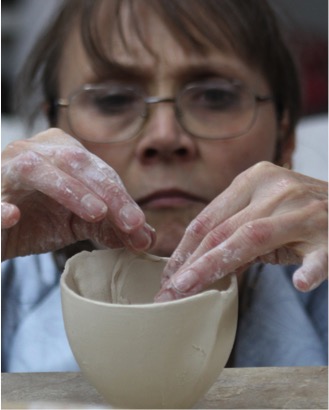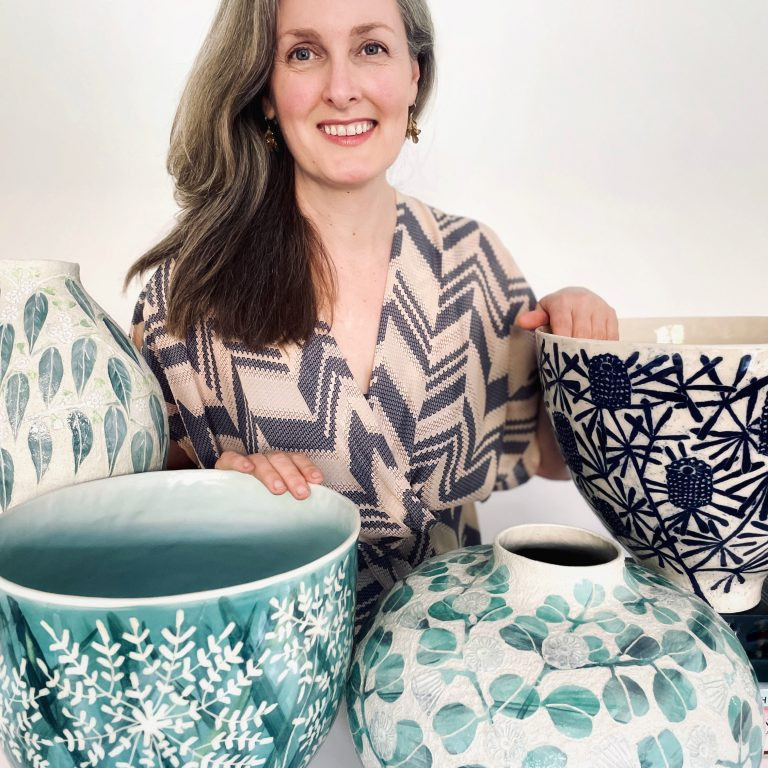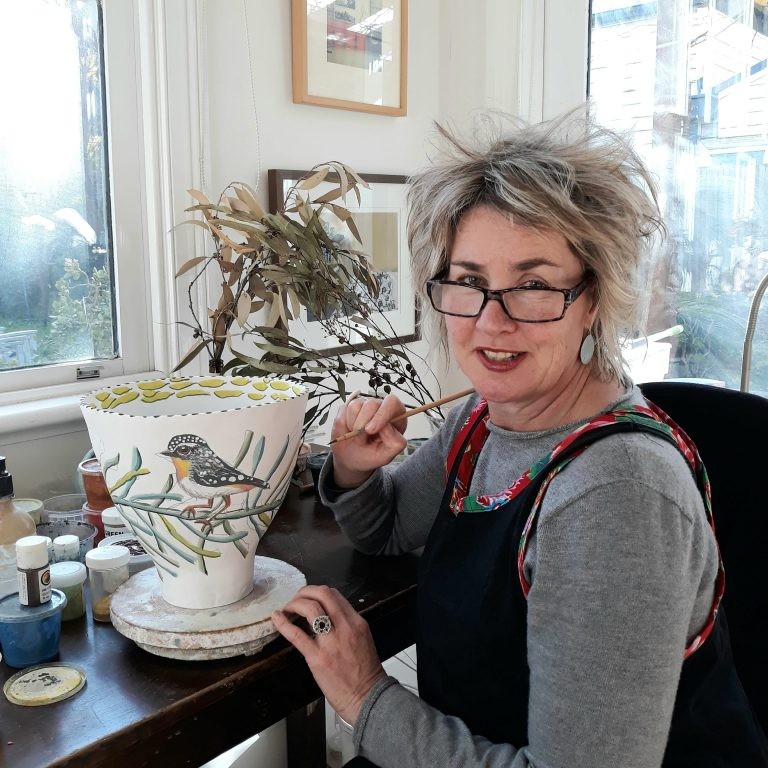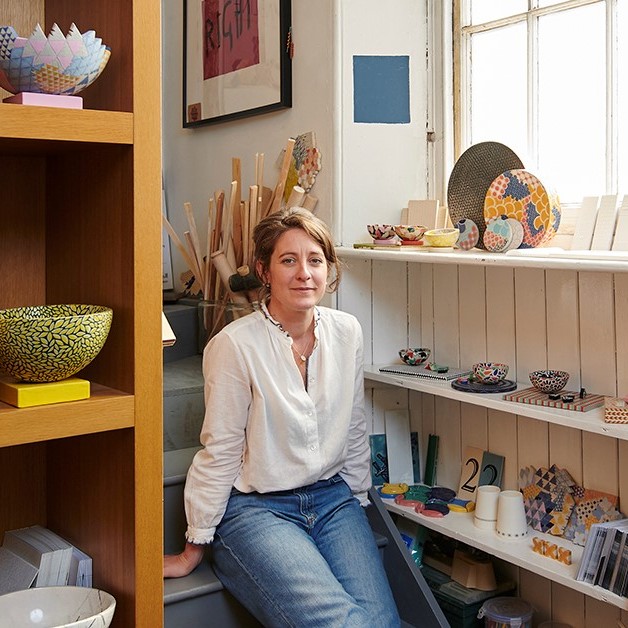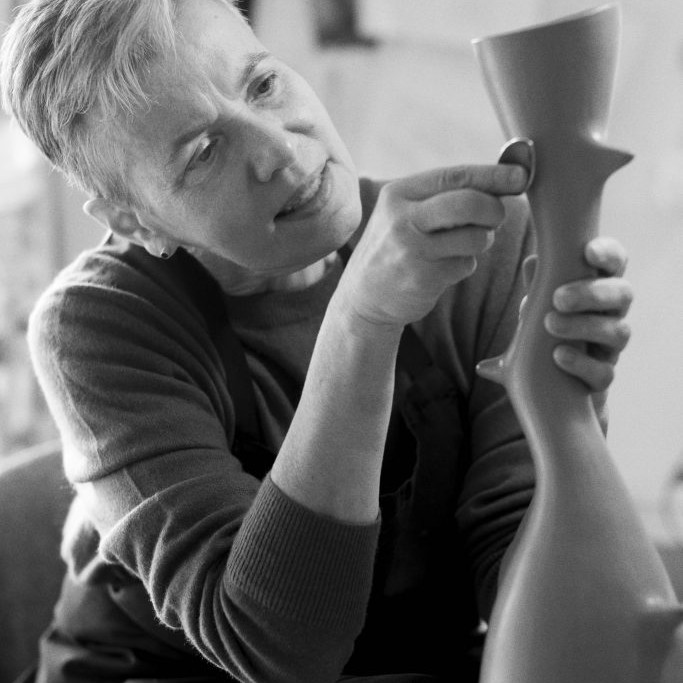Antoinette Badenhorst Ceramic Artist - Mississippi, USA
You did your training in South Africa. Was this very different from the training available in the USA?
I did a few workshops in the US, but taught mostly. I did a lot of research on the internet about the direction I was following and consulted with several potters that are more advanced than I am. They were always very generous with information.
Explain the “porcelain” in your work?
Porcelain clay is made up from pure raw materials found form different sources from across the world, thus manmade. The main ingredients of porcelain is silica ( the glass former), feldspar ( the melting agent) and kaolin (the actual clay, which in itself is not very plastic) These raw materials have a larger particle size than other clay bodies, due to the fact that it is mined at, or close to the place where it is formed. Clay manufacturers add different plasticisers to make the clay more workable these days, but often at the expense of one of the pure qualities of porcelain, which is translucency and/or whiteness.
I love the true qualities of the medium, because it reminds me of the unpolluted country in which I was raised.

Envelope
Discuss the importance of the translucent quality of your work?
I was raised in a country, where one could see mountains a 100 kilometres away on a clear day and where I learned at an early age what the differences between real water casting and mirages was.
As a child I often observed the translucency of the sky and clouds, lying on my back on the grass behind our house on the farm where I was raised.
Many days I would walk on the hillsides and this is where I became aware of rain approaching in a translucent curtain, until it poured all over me.
I dreamed my study hours away in front of the of the window of our study hall in the dorm where I lived during the week, observing how the clouds over the Khomas Hochland Mountains changed from oranges and red to purple and pink before the sun sinks behind the mountains. When the moon and stars finally appeared, it came so close and clear, that one could almost pick it from the sky.
These are qualities, among others, that I like to bring out in my work. Porcelain that is worked like clay, but are fired to a glasslike matter, allows me to do that.
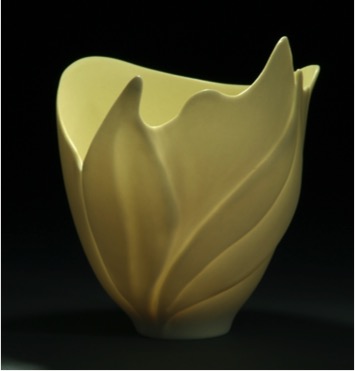
Your work is both hand-built and thrown. Explain the techniques in relation to a piece using each particular technique?
I love working on the potter’s wheel. The way that the clay moves always fascinated me, but it was years before I realized that the movement of clay, resonates with my whole philosophy about life, nature and the interaction between our physical and emotional lives and how everything goes around in circles, cycles and seasons.
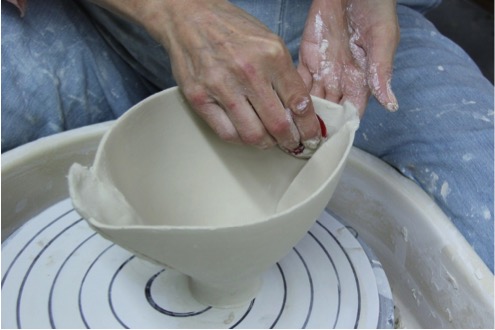
Just throwing on the wheel however, limited my vision. Not everything in life spins in a perfect circle. In fact, it spins out all the time. As humans we are affected by things that happen to us and our interaction with people around us. It brings seasons of happiness and sadness to our lives. We live and become successful in life, but then we grow old and make room for others to take our place and when we die, new babies are born.
So my original perfect wheel thrown pots had to break out and find its own way. Just as in real life, our centres do not always start from the centre, I had to find ways to “misplace” the centre and my envelopes were born.
These envelopes are formed in press moulds, which are basically shells that I put together to form an enclosed oval form. It allows me to take it in any direction that I wish to take it.
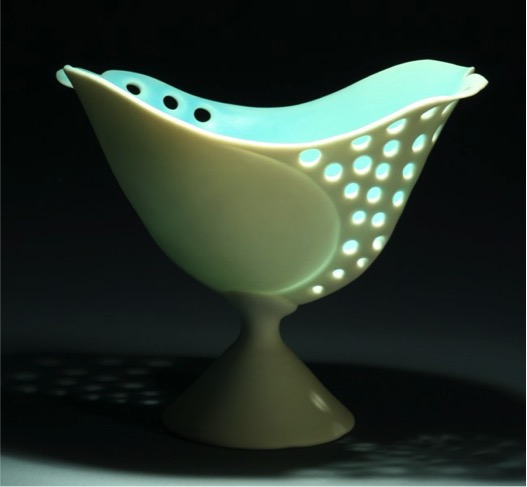
Can you explain the design process you take to make a new piece?
Much of what I do comes almost automatically, just because I am experienced with my designs, but all designs begin with some inspirational object or event, mostly directly or indirectly (a saying or a song) from nature or the lives of people around me. From there I have to either make a model or have to draw it.
This would only be the beginning, since the effectiveness of an object drawn, or modelled change as it becomes alive. I see these design processes as permission to change and re-design as I create.
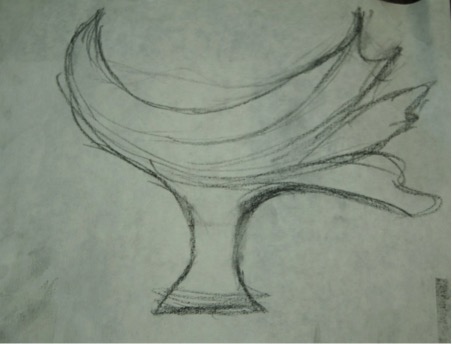
Explain how you incorporate the very old technique of pinch pots into your current work?
Pinching clay is a very underestimated and under used clay technique. I think the reason is that potters often see it as a technique to train beginners.
Just the opposite is true for me. To be able to pinch and shape a piece of clay by hand to the point where its limits are pushed and it still has a beautiful flowing quality, is a very advanced technique.
Pinching is often just the connection that is needed between two clay slabs or to extend a wheel thrown pot. It is tricky to pinch a raw piece of clay into these “smooth” surfaces and make a smooth transition. The way that one’s eye has to flow (or has to get interrupted) over a clay form, is a very important design quality that I like to use effectively and pinching clay helps to achieve that.
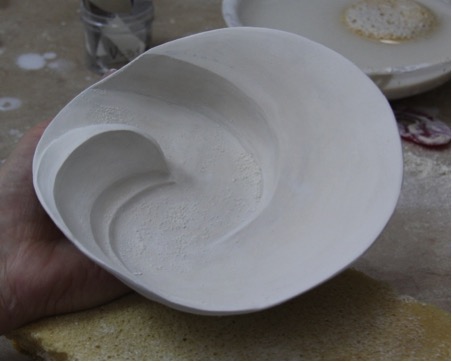
Discuss the processes you made in the firing to get the colour and glaze you require?
It is relatively easy to create porcelain glazes for high firing. The basic raw materials that will mature at 1260 are often found in porcelain clay that matures at the same temperatures. Other than stoneware and earthenware, porcelain clay and glaze becomes a single layer. The interaction of glaze and clay materials when fired to maturity makes it the strongest fired clay medium, despite its fragile appearance.
I created a few basic glazes that have a matt, satin or glassy appearance. To these basic glazes I add mason stains. I like to work along with the fashion colours of the season. I know it is not how artists are “supposed” to work, but I believe there are much more to creating art than only what I believe in. Firstly, there is no right or wrong way, but a comfortable and effective way. Art only becomes art when it resonates with someone and if colour is what attracts people, so be it.
Secondly I am personally very affected by colour. The subtle nuances of colour as it find its way through the walls of my vessels is intriguing.
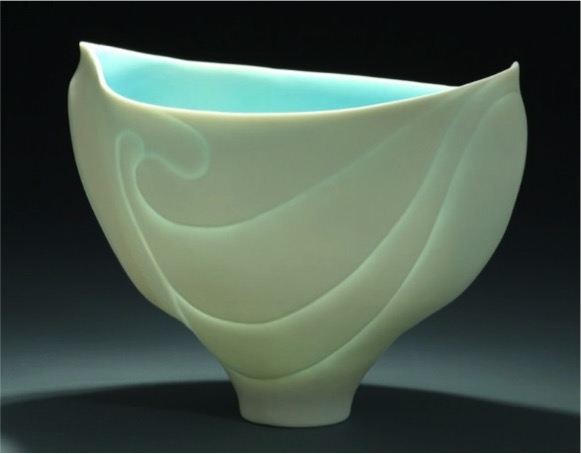
When I have to come up with a new colour, I would seldom start from scratch with a basic glaze. I would use the older mixed up glazes (I seldom mix more than 1 litre of glaze at a time) and alter it to get the required colour. An example is a soft green glaze would become a bright lime glaze the next season, just to become a yellowish old gold the year later. The challenge lies in the “reading” of the colour nuances.
It is a rule not to put more than 10% colorant into a basic glaze, so I have to keep filling the bucket up with a basic glaze. I am not always successful, but I do see one failure as an opportunity to do better next time.
Please discuss the mark you use on your work?
I allow the form of the basic vessel to lead me. Due to the nature of porcelain, I would often allow a form to find its own direction within my original design thereof. I want the viewer’s eye to move comfortably and with pleasure over smooth lines.
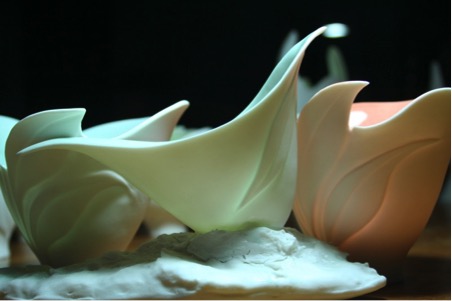
How did you develop the mark?

I use a charcoal pencil and draw lines over the leather hard clay and keep doing that until I find a pleasant line. From there I carve clay away to form a soft rounding.
Sometimes I will re-wet the clay (one of the beautiful characteristics that porcelain will allow the maker to utilize) and push parts of the wall out to place emphasis on these areas.

Where do you normally place the mark?
It depends on the form.
Sometimes I will cut parts of the rim away and follow up with incising into the wall as I described above. If it is a plate or a shallow bowl, I will carve the interior. When it is a taller object that may be seen from the side rather from inside, I will place the emphasis on the outer wall. The effects will differ, since some of it may be glazed over the marks and others will show shadow and light, mingled with colour as it seeps through the wall with the translucency.
Lately I started to carve in and out, but it is tricky, because in the translucency that may shine through, these lines has to work together to make the design successful.
What is the importance of the use of an artist’s mark?
It took me a while to develop that mark, but I believe that is what defines my communication with my viewers. I have a story/message to tell.
Nothing under this sun is new, but if I would not develop my own honest body of work within that frame, but copy someone else’s, I will not be honest to myself or anyone around me.

I trust that by looking at my work, the viewer can directly recognize an “Antoinette Badenhorst”
Can you expand on the two pots you have in the collection of the Mississippi Museum of Art?
I have one piece in the Mississippi Museum of Art collection and one in the Gumtree Museum of Art, Mississippi. The Mississippi Craftsmen’s Guild also has work in their collection.
These collectors pieces stems from my early days in the USA. At the time I was working with porcelain in a different way. I used the porcelain qualities to obtain fine
I also have works in private collections of celebrities and in Enzogama in Biei, Japan and in Museums in South Africa.
Teapots
I guess any true potter is attracted by the teapot making process, since it is a great theme for expression. It has its own design challenges and if it needs to serve as a utilitarian object too, it becomes even more complicated. Some potters will only use it as an object of ornamentation or sculpture.
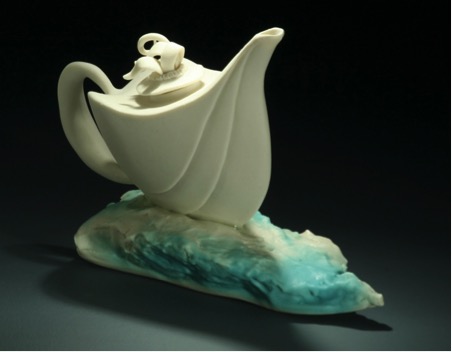
‘Teapot’
Inspiration?
Teapots fit very well into my overall theme of circles, cycles and seasons. The emotional feelings that we have often influences those around us and vice versa. It “flows” from or too us. The body of a teapot that receives liquid through an opening and then pours it out through a spout conveys the same idea.
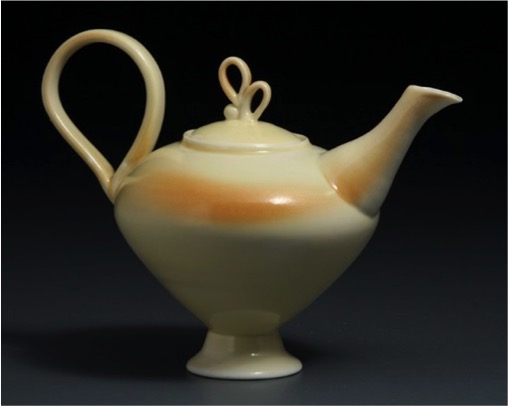
Problems in the process?
Oh, teapots have many design challenges, because it has so many parts to it that has to balance. A misplaced handle or spout will make it difficult to get a nice flow of liquid, but at the same time it may also limits a nice flow of the viewer’s eye.
Any kind of spout requires fine planning, because liquid must organize itself to move from a hollow body into a spout and out without dripping and splashing everywhere.
I have a problem with potters making heavy, oversized teapots that does not function well. Too often we may use the excuse that a heavy teapot is meant for a sculpture, but I disagree with this approach. If it looks like the real deal, it should function like the real deal.
The importance of a snug lid?
You ask questions that may get me into a very unpopular situation. LOL!

By measuring the diameter of the opening where the lid will fit and then making the flange 3/4 of the length of the opening diameter, will secure lids from falling out when pouring tea. It is a simple rule that is often ignored by teapot makers with the excuse that one should hold a teapot with both hands; on the lid and by its handle.

A frail person may prefer to hold it by its spout (there is often a little lug on the spout to help pour tea this way) and handle and not worry about a falling or spattering lid.
A snug lid with an extended flange is much more attractive than loose fitting lids. It is however important to have a little hole on the lid to allow stream to escape, or else the pressure may force it out the opening. That may cause a burning hazard.
Southern Ice Porcelain Envelopes – please explain this series?
The envelopes allow me to make larger sized pieces, without taking up too much space on a table surface. My clients like to place against a wall on a mantel or a narrow space in a cabinet or window sill. The fact that I can elevate the piece on a pedestal or stand, allow the message to grow in importance.
As a potter, I admire ancient pottery. I think the forms of my envelopes developed from antique Roman cups on pedestals, although I never hand the intention to make any replicas of any ceramic form.
There is a challenge in working with porcelain, particularly Southern Ice Porcelain. The challenge is raised with envelopes, particularly in the firing.
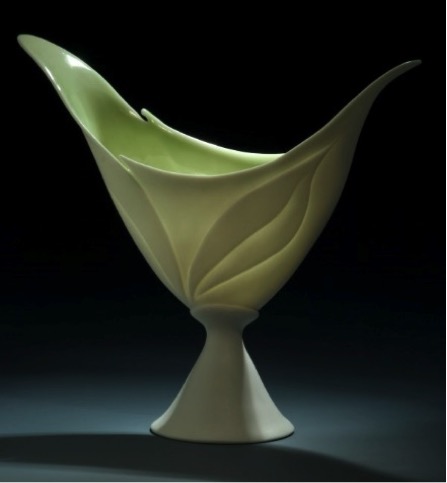
When porcelain is fired, it has a tendency to move in the kiln, because the clay becomes soft (pyro plastic). For that reason the walls of porcelain should be of even thickness and the lower parts should be stronger and sturdier to support the higher parts. My envelopes are carried by its “stem” and when it becomes soft in the firing, the top heavy part can swing into any direction and even topple over. I had to overcome this challenge by learning how to fire these pieces so that I can manipulate the movement. I love the fact that I can leave some of the movement to develop in the fire. That is part of the relationship that I built with the porcelain clay medium, but I have to be very careful in how I place the work in the kiln and not allow the “Diva” to take over completely.
As far as my marks are concerned, I use the same approach as with other clay techniques.
Do you always have a Christmas range?
Not always. In South Africa Christmas is summertime. We did not place that much emphasis on Christmas trees. Here in the States, lights brighten our days and I started out with series of ornaments some years back.
Explain your 2014 Christmas flags?
There is no true challenge in the making of it for me. I used a design that is recognized anywhere in the world, but that carry the triumph of overcoming the difficulties of immigrating to the USA. Every American that owns one of my flags, celebrate that triumph with me!
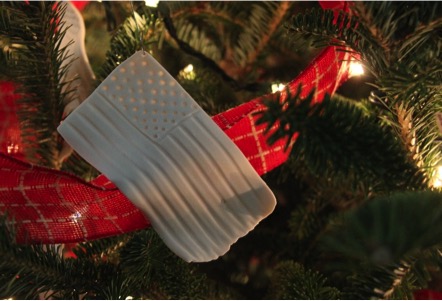
Can you tell us a little about your e-courses?
We love it. I had people contacting me from across the world to ask questions about porcelain and it is often difficult to explain, while it is so much easier to show.
In 2014 my husband Koos, who is my manager and also the person behind my porcelain images and website, and I put a curriculum together for our first “Understanding Porcelain” e-course. We decided that we want to present a workshop to potters, similar to those that I present live at ceramic schools and institutions. We knew we had the ability to bring our classes to people around the world and particularly those that may never have the opportunity to learn in another way than through the internet.
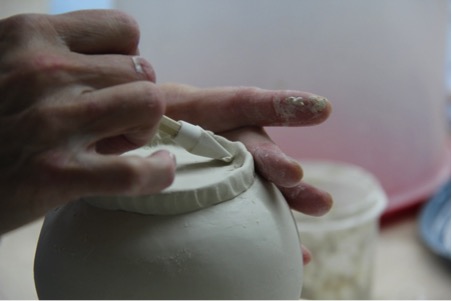
We realized that we can give every student a front row view with videos, but we also had to compete against so many “how to” videos that roam the internet.
We created a forum online through which our students can communicate with us and ask questions. We make it as personal as the internet allows us and by the end of this year we created 2 more courses; “hand building porcelain” and “hand building porcelain dinnerware” Each of these courses was per request of our students. The next logical follow-up will be “Wheel Throwing Porcelain Dinnerware” that we will launch after the re run of “Understanding Porcelain that starts January 5th.
Our classes are set up in a way that it place the emphasis on porcelain, but do not exclude students that want to work in other clay bodies, but would like to learn about clay techniques in general.
We hope to continue with more of these courses in 2015 and even expand it beyond our own studio.
“It is my ongoing task to encourage young and upcoming artists to strive for those elements in their work.” Please discuss?
I was a beginner once in my life. I try to remember that when people ask me questions. I remember how many times I opened a kiln and wanted to throw the towel in. I remember how long it took me to find my way. Other than what people often think, pottery is one of the most difficult mediums to master, because there are 3 main parts to it: learning to master techniques, learning the science behind the medium and learning to express oneself as an artist through clay. Apart from that, there is physical labour involved in pottery making, but the three parts mentioned cannot stand loose from each other if one wants to become successful as a potter.
I love to be a mentor for those potters that take their work serious and that want to grow in and through their clay work.
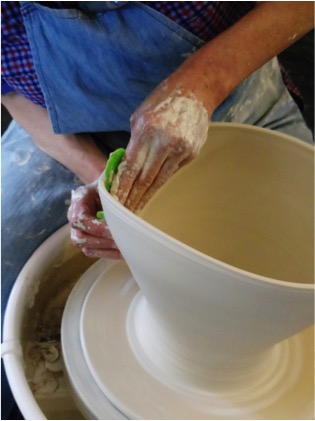
You do international workshops. Can you expand on your workshop in South Africa?
We were traveling through South Africa and Namibia over a period of 6 weeks in 2014 and had the opportunity to meet with old pottery friends and met new ones while I was presenting demonstrations and hands-on workshops in Port Elizabeth, Cape Town and Johannesburg. We stayed with potters and had a very enriching experience.

It was a great opportunity to give back to a potter’s community that raised me as a potter. I was honoured to present the knowledge that I gained here in the USA over the past 15 years to people that was previously my teachers and mentors and as it always is when one give yourself unconditionally, I got so much more back from these people that what I gave them.
Discuss salt in your work and how it relates back to cooking and your daughter?
This relates back to the science of pottery. Much of what I know today was from research that I did as a young potter. In those early days of making pottery, the whole clay process was overwhelming to me. When I learned that by using salt (as it relates to salt firing)can make a simple glaze, I thought the salt that is referred to, is the scientific name for some difficult-to- explain clay medium.

Our middle daughter is a celebrity chef. She gave me some rocks of salt that makes a beautiful display on my kitchen counter. It often reminds me of my early days, when I randomly put salt in the kiln to see what would come out, without knowing how to use it.
I also believe that salt is associated with sincerity as it is described in the Bible.
Can you discuss your thoughts on the importance of the connection between potters and chefs?
Practicing pottery as I mentioned before, is a difficult medium to master. Potters are very passionate creatures as it must have shown in my answers to you by now. Therefor we do not always realize the implications of making things that become permanent objects. Once a piece of clay is fired, it is as hard as rock and even when we break it to pieces; it will stay on earth for as long as it would take for a rock to erode.
As potters we have a responsibility towards our clients. If a food container is carrying a health hazard in some or other way, we should distance ourselves from it.
On the other hand there is something hearty and very personal about eating from a handmade plate. Just like we have our own doctors and therapists today, people had their personal potters before the industrial revolution.
There is a reliving of the art of cooking and to grow our own fruit and vegetables, so it is a perfect time to let the pottery object in households relive too. To become successful, potters should work with chefs to learn what their needs are. After all; potters, chefs and the eating public can create a perfect balanced relationship.
I have the perfect opportunity to learn from my daughter what is needed to present to chefs a perfect container, while she has the perfect opportunity to learn from me what a plate should not be.

Contact Details
www.porcelainbyAntoinette.com
Antoinette Badenhorst, Mississippi, USA
Interview by Deborah Blakeley, January, 2015
Think a colleague or friend could benefit from this interview?
Knowledge is one of the biggest assets in any business. So why not forward this on to your friends and colleagues so they too can start taking advantage of the insightful information the artist has given?
Other artists you may be interested in:


